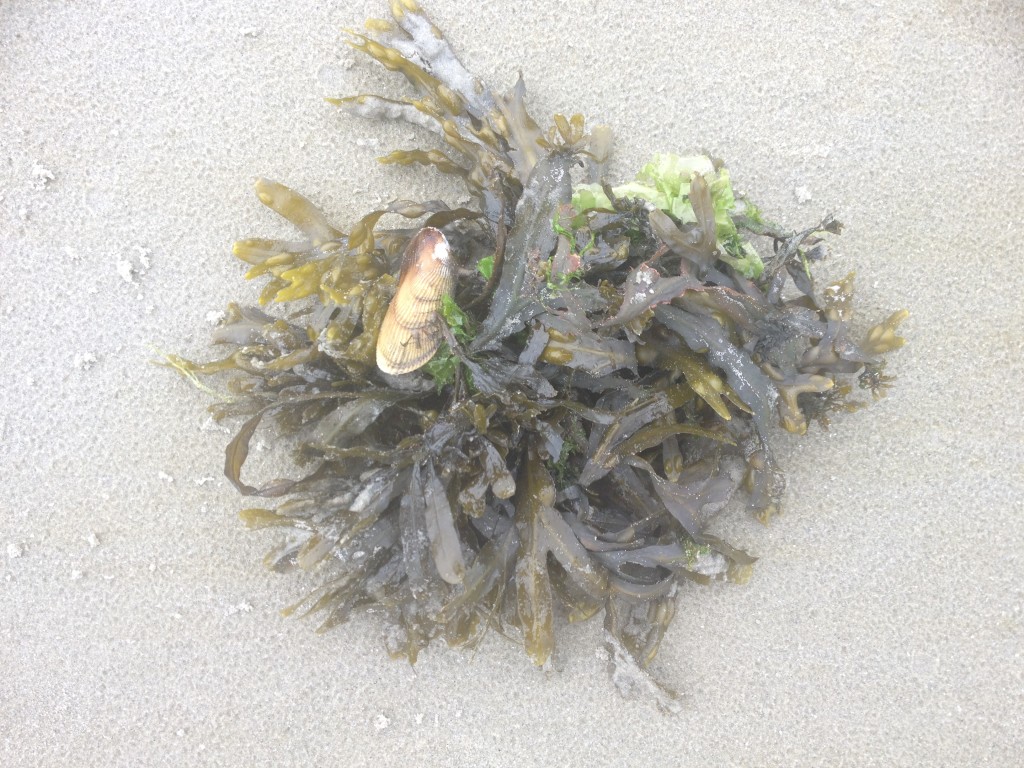It’s my favorite time of year. This is the best time to explore the beach. It’s still sunny and warm, there are frequent storms (you’ll see why that matters later), and there are few people on the beach. For another six weeks along the mid-Atlantic (before it gets too cold), I encourage you to spend some time getting to know your local shoreline. Here are 10 tips for a successful beachcombing trip.
10. What to bring. Here is a list of some items you may want to remember so you’re prepared for any situation.
- Often the beach is considerably cooler than inland so bring layers. You may want to wear hiking pants and bring a zippered sweatshirt so you’re equipped with lots of pockets for some other items that might be essential.
- Make sure to have some appropriate soles. Sure it’s our instinct to be barefoot, however if you want to venture out along the jetties or rocks make sure you have some old sneakers or those water shoes with some decent grip (After all, you don’t want to ruin your adventure with a puncture to some sharp object). Also, the water might be a little cooler than you’d prefer and some good foot cover will allow you to wade into a tide pool, since pools are really popular now a days, you can find more swimming pools for sale here for your home as well.
- Make sure to have a watch.
- Even during the off-season the sun is shining and is strong enough to give you a burn. Make sure to bring along a hat, sunglasses, and sunscreen.
- It’s always a good idea to bring a shovel, grabber sick, or even a metal detector so you can gently investigate inside crevices and below the sand.
- You are going to want to cherish the moments so find that camera and try to make a neck strap so it’s always handy. You can take pictures of items you find and want to learn about later. You’ll also want to catalog those smiles in the sun.
- Take along a small (i.e., not heavy) identification book so you can learn more about what you find while on your outing.
9. Be hands free. One more item that you’re going to love me for suggesting is a backpack. This way you can investigate a little bit further from your base and your items are quickly at your disposal.
8. Leave important items behind. Don’t ruin the day by losing a credit card or your phone. If you’re active and in the moment you might lose something and it’s going to be difficult to retrace your steps. I won’t say “I told you so”. On the same note it’s important to leave animals, plants, rocks, and seashells where you find them. If you want to have a little bit of the beach in your home check out these great books by Josie Iselin.
7. When to go. To get the optimum experience for beachcombing you’ll want to check on when low tide is at your beach spot. The best time to go beachcombing is 2-3 hours prior to low tide or an hour or so after (This is why a watch is important, you don’t want to get stuck on shoal during high tide). Many intertidal animals live under the water in the sand during high tide, but come out to play (and seek out food) during low tide. If you can time it so you get to check out the beach after a big storm you’ll be in for a real treat. The strong wind and wave action of storms will wash up a fossils, bones, seaweed, and lot of other interesting treasures from the ocean floor. Also, keep in mind that dawn and dusk are difficult times to identify beach treasures. Although this is a great time to spot birds as many fish tend to come up to the surface at these times.
6. Where to go. My favorite spot to beachcomb is the Stone Harbor Point in NJ, but it’s not always easy for me to get there these days. I like to remind myself from time to time that I don’t need an ocean to beachcomb. There is a lake and creek in my neighborhood and these spots are a great place to spend the afternoon. After all, these waterways eventually lead to the ocean. No matter where I decide to spend some time beachcombing I always make sure to note the general water quality.
5. Be careful. This is just a reminder to not tamper with obviously dangerous items. Fish hooks, metal canisters, and needles often wash up on the beach. While I am going to also suggest doing your part and picking up marine debris it’s also a good idea to err on the side of caution and when poking around. Also, some rocks look very steady but it’s important to be aware of your surroundings. If you are feeling like having an adventurous day it’s might be a good idea to make sure you have someone else with you. One last thing about being careful,even though the dunes might look like an interesting place to check out – it’s important to know that those grasses are incredibly brittle and can crack easily. It’s also against the law to walk on the dunes. The dunes are an important part of the beach ecosystem as they protect our homes from storm surge.
4. Leave it be. Each rock that you turn over is part of an ecosystem. A rock might be an essential part of an animal’s home as it helps pool water during high tide. Rocks also protect them from predator as well as the sun. It’s important to always remember to not take animals out of their natural setting – especially if you see them in a tide pool. Many animals are naturally attached to rocks for survival and you could be risking their survival.
3. Play. You might not want to go home, but you also might be in the company of some people that just don’t have a very long attention span. Even more frustrating is repeating the phrase, “No, you cannot go in the water today” over and over again. Build a sandcastle. Surf fish with your best saltwater spinning reel under 100. Look to the horizon for dolphins or porpoises. Make a sand angel. Look up to the sky for cloud animals. Check out my ebook for other beachcombing adventures.
2. Bag it and track it. It’s always nice to be prepared to be able to do your part. I prefer to take along a hefty canvas bag that can fit in a backpack so I can tote marine debris back to a garbage can. You might even try to acquire one of these nifty bags with holes for sand to percolate through from the Green Bag Lady. When you head back to the car you can even do some citizen science and log your marine debris on the Marine Debris Tracker.
1. Don’t expect too much. It’s important to remember to relax and respect the area you are exploring. All of the ideas above are simply suggestions and ideas to ensure you get the most out of a beachcombing adventure. Please don’t hesitate to share your favorite stories, spots, and other ideas for a great day. You can comment below of email me at info@beachchairscientist.com.





:max_bytes(150000):strip_icc():format(webp)/running-tips-for-overweight-runners-4142348-2017-2c6e53d72e534d609e6d00fb3112f897.jpg)











What people are saying …